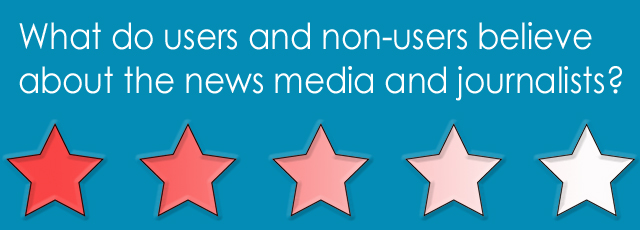
Q5: How do mobile and non-mobile media users perceive the news media and journalists?
2012 RJI Mobile Media News Consumption Survey
A majority of respondents overall — mobile media users and non-users — shared a generally favorable opinion of professional journalists, when asked if they agreed or disagreed with a series of statements on a five-point scale. That’s the good news. The bad news, or shall we say the “more thought-provoking news,” is that respondents in both categories also were about equally conflicted in their attitudes regarding the mainstream news media and the transition to mobile digital news technologies.


Nearly two-thirds of the mobile media users and non-users indicated a preference for news stories produced by professional journalists and nearly three-quarters agreed that journalists play an important role in our society. That would seem to bode well for established news organizations that are betting on apps for mobile media devices to generate significant revenue from their journalistic content in the not-too-distant future.
However, our deeper analysis of data gathered from this phone survey in the first quarter of 2012 reveals much more complex and often conflicting attitudes that are likely to influence news consumption on mobile media devices. Trust may be the single most important factor as well as the most conflicted.

Responses to the statement “I don’t trust the main-stream news media” exemplified the conflict. Overall about a third of the respondents agreed (implied distrust), a third disagreed (implied trust), and a third were neutral. As the top chart shows, the differences in attitudes between mobile media users and non-users, in the aggregate, were relatively minor.

More pronounced differences within and between these two categories were found by cross tabulating the demographics of respondents and their responses to specific questions. Among the most significant was the difference in attitudes between men and women. With this statement, our findings suggest that women are much more likely than men in both categories to trust the mainstream media. Coincidentally, we found that women are somewhat more inclined than men in both categories to subscribe to printed newspapers and/or newsmagazines.

Differences in attitudes between age groups also were more pronounced and somewhat surprising. Respondents between the ages of 18 and 34 in both categories implied that they were much more likely to trust the news media. Whereas mobile media users 35 and older were more likely to be distrusting. The responses from non-users 35 and older were close to those of non-users 18-34, with a higher percentage trusting than distrusting.

The most conflicting attitudes were found when we cross tabbed responses to this statement with the respondents’ favorite television news channels. Overall, 52% of the respondents who favored Fox Cable News distrusted the mainstream media versus 22% who implied trust (26% were ambivalent). In contrast, less than 20% of those who said a major national broadcast network — ABC, CBS and NBC — was their favorite TV news channel indicated that they distrusted the mainstream news media. More than 50% implied trust.
The differences in attitudes between mobile media users and non-users were even more conflicting. Among those who favored Fox Cable News, 60% of the non-users versus 48% of users implied distrust of mainstream news media. In both categories, those who favored ABC, CBS and NBC were much more likely to trust than distrust the news media. Only 8% of the mobile media users who favored ABC News implied distrust. Those who favored CNN were the most ambivalent. In both categories, about 41% said they were neutral.


The influence of Fox Cable News on the attitudes of U.S. adults regarding the mainstream news media and professional journalists cannot be overlooked. Fox Cable News was identified by the most respondents in both categories as their favorite national TV news channel. CNN was a close second among mobile media users and fourth among non-users. Nearly 20% of the non-users and 14% of the users indicated that they had no favorite TV news channel. These two groups combined were second only to Fox Cable News in their implied distrust of mainstream news media (39% agreed and 32% disagreed).
Responses to the statement “I expect to get all of my news from mobile digital services within the next 10 years” also were among the most conflicted. Overall, significantly more respondents disagreed than agreed with this statement. Somewhat surprising was the skepticism implied by respondents between the ages of 18 and 34.

Among mobile media users, respondents in the 18-34 age group were more skeptical than those in the older age groups that they would be getting all of their news from mobile media devices within 10 years. Non-users in the 18-34 age group also were skeptical, but not as much as non-users 35 or older. Perhaps equally surprising was our finding that mobile media users in the 55 and older age group were significantly less skeptical than non-users in the same age group, as well as less skeptical than those in the younger age groups within both categories.

Responses to the statement “I prefer to get only the news that interests me” revealed a number of differences in attitudes between age groups as well as between mobile media users and non-users about preferences for personalized news.
Mobile media users between the ages of 18 and 55 indicated a strong preference for getting only the news that interested them. Those who were age 55 or older were significantly less enthusiastic about getting personalized news, with more respondents in that age group disagreeing than agreeing.
Among non-users, the differences in attitudes between those who were younger than 35 and those who were older were more pronounced. The responses of non-users in the 18-34 age group were somewhat less enthusiastic about personalized news than mobile media users in the same age group, but they were significantly more enthusiastic than non-users age 35 and older.

With the rapid growth of social media, we assumed that younger users of mobile media would show a strong preference for getting most of their news from friends they trust. Responses to the statement “I prefer to get most of my news from friends I trust” seem to contradict that assumption. Only 20% of mobile media users in the 18-34 age group agreed, while more than half disagreed. Nearly the same percentage of users 35 or older agreed and a somewhat higher percentage disagreed.
Interestingly, the preference for getting most news from trusted friends was significantly greater among non-users than users in the 18-34 and 35-54 age groups. While social media is expected to have a greater impact on news media in the years ahead, it appears unlikely to become the main source of news. Connections to friends (physical and virtual) via social media may function more often than not as an alert service that directs users to stories provided by news organizations.

Responses to the statement “News is news; it doesn’t matter to me who produced it” would seem to lend support to the argument that news stories provided by news organizations and professional journalists are still valued by most people. As the above chart shows, well over half of the mobile media users and non-users in all age groups disagreed with this statement.
However, there was a somewhat puzzling reversal of attitudes by age groups within each category. Within the mobile media users category, the 55 or older age group indicated the highest regard for the sources of news, whereas within the non-users category it was the 18-34 age group that cared most about who produced the news content.
Respondents in both categories who indicated that they subscribed to printed newspapers and/or newsmagazines also indicted a higher regard for the sources of news than those who did not subscribe.

Responses to the statement “I consider advertising to be useful content” were as bipolar as the responses to the “I don’t trust the mainstream news media” statement, and just as conflicting.
The differences in attitudes regarding advertising were greatest between mobile media users and non-users in the 55 or older age group. Users in this age group were less likely to agree with this statement than users in the younger age groups. They also were the most ambivalent. Among the non-users, significantly more respondents in this age group agreed with this statement that non-users in the younger age groups. And they were the least ambivalent.
In both categories, women and respondents in the 18-34 age group were more likely to agree than disagree. Non-users who subscribed to printed newspapers also were more likely to agree (43%) than disagree (30%). Mobile media users who subscribed to printed newspapers were more evenly divided on the usefulness of advertising (33% agreed and 35% disagreed).

Overall, less than a quarter of all respondents agreed with the statement “I am willing to pay extra to get my news without advertising.”
The notable exceptions were mobile media users in the 55 or older age group — one third agreed and half disagreed.
Mobile media users who subscribed to newspapers were only slightly more willing than the average (28% agreed) to pay extra for news without advertising.
Taken together with the responses to all of the previous statements, this would seem to suggest that digital content produced by professional journalists for mobile media devices has perceived value, but charging for access, with or without advertising, will continue to present news organizations with a dilemma for the foreseeable future.
We intend to explore this issue more specifically in our future mobile media news consumption surveys.
